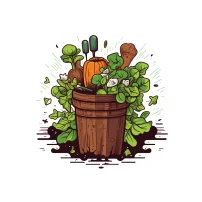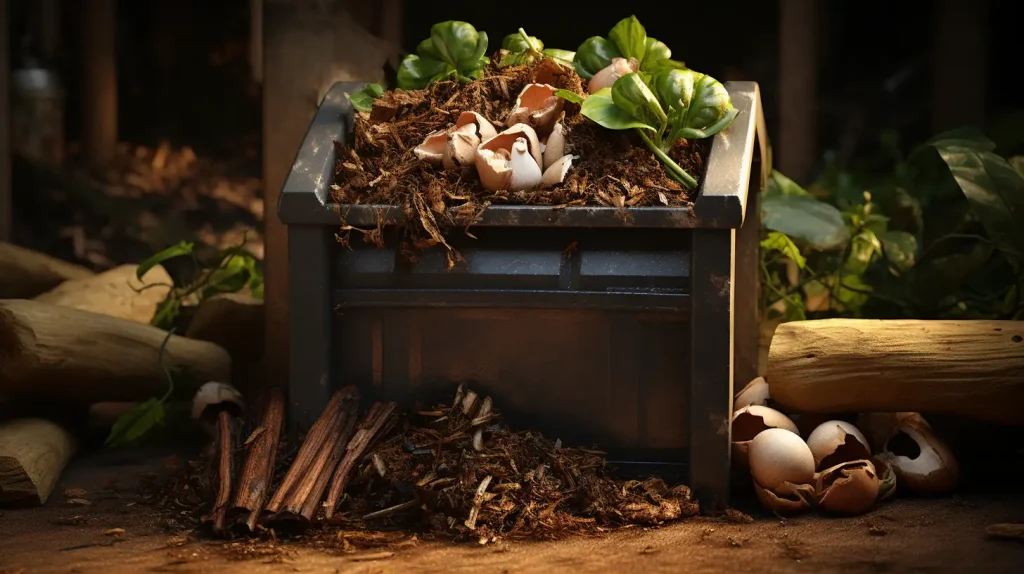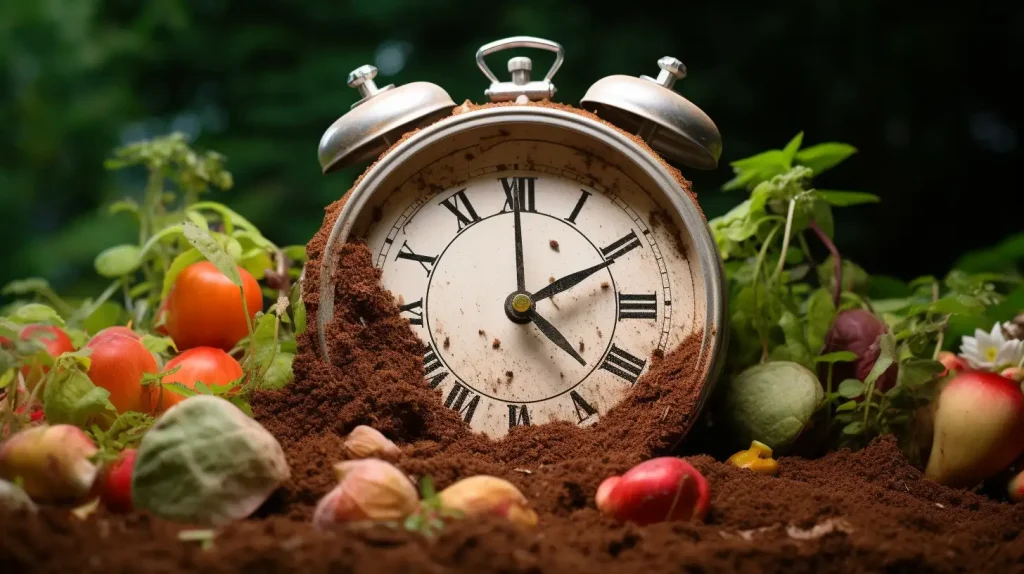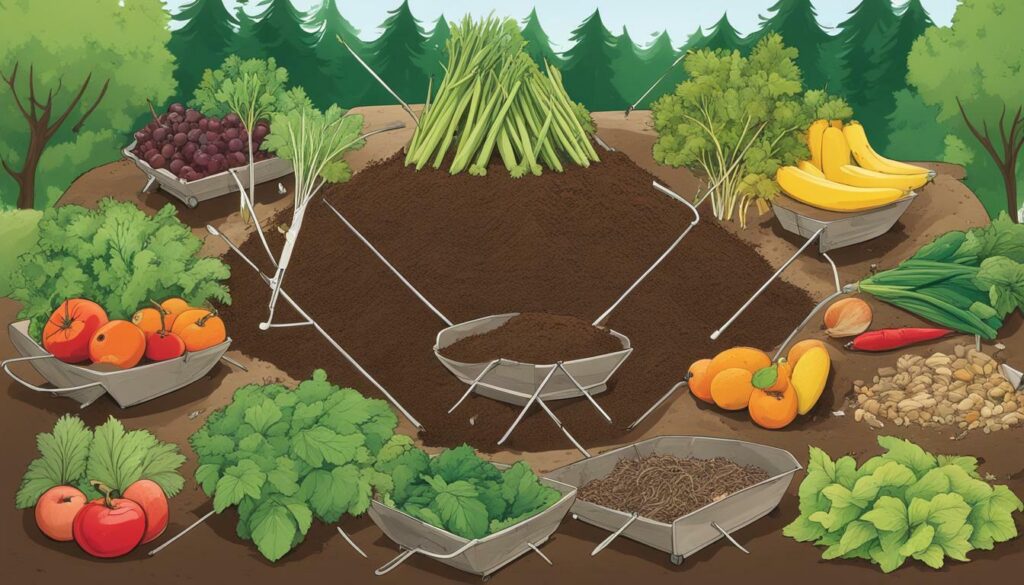Composting is a process that involves the natural decomposition of organic waste materials to produce nutrient-rich compost. This process is not only environmentally beneficial but also helps gardeners create healthy soil for their plants.
Composting is achieved through a combination of organic waste decomposition and microbial activity. This process breaks down waste materials into a rich, soil-like substance that can be used to improve soil quality and promote healthy plant growth.
Key Takeaways
- Composting is a natural process that involves the decomposition of organic waste materials into nutrient-rich compost.
- The composting process occurs through a combination of organic waste decomposition and microbial activity.
- Composting is beneficial for both the environment and gardeners as it helps to reduce waste and improve soil quality.
The Basics of Composting
Composting is the process of breaking down organic waste into nutrient-rich soil, which can be used to fertilize plants and gardens. Organic waste decomposition is facilitated by microorganisms that consume the waste and produce compost.
The composting process can be broken down into three stages:
- Initial breakdown: In this stage, bacteria and fungi break down large organic materials, such as leaves and twigs, into smaller pieces.
- Active decomposition: In this stage, microorganisms consume the organic waste, producing heat as a byproduct. This process generates temperatures of 140 to 160 degrees Fahrenheit, which kill pathogens and weed seeds in the compost.
- Curing: In this stage, the compost matures, losing heat and stabilizing. This stage can take several months or up to a year.
To create compost, two primary materials are needed:
- Browns: Carbon-rich materials such as fallen leaves, branches, and newspaper.
- Greens: Nitrogen-rich materials such as grass clippings, fruit and vegetable scraps, and coffee grounds.
To ensure a successful composting process, it’s essential to maintain the correct balance of browns and greens. Too many browns can slow down the composting process, while too many greens can create a smelly, slimy mess. A good rule of thumb is to maintain a ratio of about three parts browns to one part greens.
Choosing the Right Composting Method
There are several composting methods available, each with its own pros and cons. It’s important to choose the right composting method that fits your needs and lifestyle.
Traditional Backyard Composting
The traditional backyard composting method involves creating a compost pile in your yard. This method requires minimal setup costs and is easy to maintain. It’s best suited for those with a yard or garden and who are willing to invest time and effort into managing the compost pile.
The process involves layering green and brown materials in a bin or pile, ensuring adequate moisture, and turning the pile occasionally to aerate it. Traditional compost piles can take anywhere from several months to a year to produce compost.
Vermicomposting
Vermicomposting involves the use of worms to break down organic materials. This method is ideal for those who live in small spaces like apartments and condos and do not have a yard. The process requires a compost bin, bedding materials, and red worms.
Worms break down organic matter and produce nutrient-rich castings that can be used as compost. Vermicomposting is a faster process than traditional composting and can take only a few weeks to produce usable compost.
Compost Tumblers
Compost tumblers are a popular option for those who want to speed up the composting process. These devices require less maintenance than traditional compost piles and produce compost faster. They are ideal for those who want to compost but have limited space or are not able to physically manage a compost pile.
Compost tumblers work by rotating the compost, which helps break down organic matter and aerate the compost. They typically produce ready-to-use compost in as little as four to six weeks.
Choosing the right composting method depends on your lifestyle, living space, and level of commitment. Regardless of the method you choose, composting is an excellent way to reduce organic waste and contribute to a more sustainable future.
Getting Started with Composting
Starting a compost pile may seem daunting, but it is a simple process that can be done by anyone. Here are some steps to help you get started:
- Select a composting location: Find a spot in your yard that is convenient to access, but out of the way. Composting can create some odor, so it’s important to keep it away from areas where people congregate.
- Prepare the compost bin or pile: You can use a ready-made bin or build your own using materials like wire mesh or wood. Ensure that it is sturdy and has adequate drainage.
- Add the right mix of materials: To start composting, you need a mix of brown and green materials. Browns are dry materials like leaves, branches, and straw. Greens are wet materials like fruit and vegetable scraps, coffee grounds, and grass clippings. Aim for a 50/50 mix of browns and greens.
Once you have your compost pile set up, you will need to maintain it properly. Ensure that it is moist, but not too wet, and turn it regularly to promote oxygen flow. By doing this, you will speed up the composting process and end up with nutrient-rich compost for your garden.
What Can and Can’t Be Composted
When it comes to composting, not all materials are equal. Some items are suitable for composting, while others should be avoided. Here’s a list of both:
Composting Materials
The following materials are great for composting:
- Fruit and vegetable scraps
- Coffee grounds and filters
- Tea bags
- Eggshells
- Grass clippings and yard waste
- Leaves and twigs
- Shredded newspaper
- Cardboard and paperboard (shredded)
- Cotton and wool fabric scraps
- Hair and fur
These materials provide the necessary carbon and nitrogen for the composting process.
Non-Composting Materials
The following materials should not be composted:
- Dairy products (milk, cheese, butter)
- Meat, fish, and bones
- Fats and oils
- Plastic and synthetic materials
- Coal and charcoal ash
- Colored paper
- Human and pet waste
- Invasive weeds
- Diseased or insect-infested plants
These materials can attract pests, introduce harmful bacteria, or disrupt the composting process.
The Composting Process in Detail
Composting is a natural process that involves the breakdown of organic matter, such as food scraps and yard waste, into nutrient-rich soil amendment. This process is facilitated through the work of microorganisms, such as bacteria and fungi, which decompose the materials and release carbon dioxide, heat, and water as byproducts.
The composting process can be divided into three stages:
- Mesophilic stage: This is the initial stage of composting where bacteria break down easily degradable materials, like sugars and starches. The temperature of the pile rises to about 100-115°F and can last for several days or weeks.
- Thermophilic stage: During this stage, thermophilic or heat-loving bacteria start decomposing tougher materials like fats, proteins, and lignin. The temperature of the pile can reach up to 160°F and can last for several weeks to months.
- Curing stage: In the final stage, the temperature of the pile starts to drop, and the compost matures as it continues to decompose slowly. The finished compost will be dark and crumbly and may take up to several months to form.
Several factors influence the composting process, including:
- The carbon-to-nitrogen (C:N) ratio: A balanced C:N ratio of 25-30:1 is ideal for composting. Carbon-rich materials, such as leaves and sawdust, provide the energy source for the microorganisms, while nitrogen-rich materials, such as grass clippings and food waste, provide the protein source.
- Mixing: Regularly mixing the compost pile with a pitchfork or compost aerator helps to ensure even decomposition and adequate aeration.
- Moisture: The compost pile should be kept moist, but not too wet or dry, for the microorganisms to thrive. The ideal moisture level is 50-60%.
- Aeration: Adequate aeration is essential for the microorganisms to breathe and break down the organic materials. Aeration can be achieved by turning or mixing the compost pile regularly or using a compost tumbler that rotates the compost automatically.
- Temperature: The temperature of the compost pile is a crucial factor that influences the rate of decomposition. The ideal temperature range is 120-160°F for the thermophilic stage, and below 100°F for the curing stage.
By understanding the composting process in detail, you can better manage your compost pile and ensure that it produces high-quality nutrient-rich compost that will benefit your garden.
Troubleshooting Common Composting Issues
Composting can be a rewarding experience, but it’s not without its challenges. Here are some common composting issues and tips to help troubleshoot them:
1. Foul Odors
If your compost pile has a bad smell, it could be due to too much moisture or not enough oxygen. To fix the issue, try turning the compost pile to increase airflow and add dry materials like leaves or sawdust to absorb excess moisture.
2. Pests
Pests like rodents, flies, and ants can be attracted to your compost pile. To deter them, avoid adding food scraps that are high in protein, like meat and dairy, and bury your kitchen scraps deep into the pile. If pests are already present, cover the pile with a layer of soil or newspaper to smother them.
3. Slow Decomposition
If your compost pile is taking longer than expected to decompose, it could be due to not enough nitrogen-rich materials. Try adding more green materials like grass clippings or kitchen scraps, and make sure your pile is getting enough oxygen by turning it regularly.
With these tips in mind, you can overcome common composting challenges and enjoy the benefits of nutrient-rich compost that will help your garden flourish.
Harnessing the Benefits of Composting
Composting is not only good for the environment, but it also offers numerous benefits for gardeners. Here are some of the ways in which composting can benefit you:
- Reduced waste: Composting diverts organic waste from landfills, helping to reduce greenhouse gas emissions and the amount of waste piling up in our communities.
- Enriched soil: Compost is a natural fertilizer that enriches soil by providing essential nutrients and promoting healthy microbial activity. This can lead to bigger yields and more vibrant plants.
- Conserved water: Compost helps soil retain moisture, reducing the need for frequent watering.
- Cost savings: Composting can save money by reducing the need for synthetic fertilizers and pesticides.
By composting, you are not only contributing to a more sustainable future, but also reaping the rewards of a healthier garden.
How Long Does Composting Take?
The amount of time it takes for organic waste to turn into compost depends on various factors, such as the composting method used, the materials used, and the conditions of the pile.
Typically, the composting process can take anywhere from a few weeks to several months. Composting involves a natural process of decomposition, which is facilitated by microorganisms. These microorganisms break down the organic matter into nutrient-rich compost.
The decomposition process is influenced by several factors. The most important factors include moisture, temperature, oxygen, and the carbon-to-nitrogen ratio (known as the C/N ratio) of the compost pile.
The ideal moisture level for a compost pile should be about 50%. Too much moisture can lead to anaerobic conditions, which can create unpleasant odors and slow down the decomposition process. Meanwhile, too little moisture can cause the compost pile to dry out and slow down the decomposition process as well.
Temperature is another critical factor in the composting process. Microorganisms that facilitate decomposition function best within a specific temperature range. The ideal temperature range for most composting processes is between 120 and 160 degrees Fahrenheit. As the temperature rises, the decomposition process accelerates.
Oxygen is necessary for the aerobic microorganisms that facilitate decomposition. These microorganisms require oxygen to function properly. Lack of oxygen can cause anaerobic conditions, which can slow down the decomposition process and create unpleasant odors.
The C/N ratio of the compost pile is the ratio of carbon-rich materials (known as “browns”) to nitrogen-rich materials (known as “greens”). The ideal C/N ratio for most composting processes is between 20:1 to 40:1. A low C/N ratio can cause the compost pile to become too nitrogen-rich and lead to a foul-smelling pile. Meanwhile, a high C/N ratio can cause the composting process to slow down.
As a general guideline, composting can take anywhere from several weeks to several months. The length of time depends mostly on the size of the pile and the materials used. For faster results, consider using a hot composting method, which involves creating a pile that heats up quickly to promote faster decomposition.
Using Compost in Your Garden
Compost is a valuable addition to any garden. It improves soil structure, enhances moisture retention, and adds essential nutrients to the soil. Here are some tips on how to use compost in your garden and reap the benefits of your hard work composting!
Soil Amendment:
Mix compost into your garden soil to enhance its fertility and structure. Spread a 2-3 inch layer of compost on top of your garden bed and mix it into the top 6 inches of soil. This will provide a nutrient-rich base for planting and allows for better root growth.
Potting Mix:
Compost can be added to potting mix to create an enriched growing medium. Mix equal parts of compost, sand, and peat moss to create a well-draining potting mix. This yields a mix that is perfect for container plants and provides them with the nutrients they need to grow strong and healthy.
Top Dressing:
Apply a layer of compost on top of your garden soil and around your plants to provide a slow-release of nutrients throughout the growing season. This top dressing method helps to suppress weed growth, conserve moisture, and add vital nutrients to the soil.
Mulching:
Spread a layer of compost around your plants to create a protective layer that will help to retain moisture and regulate soil temperature. This mulching technique will also help to control weed growth and reduce the amount of water needed to maintain healthy plants.
By using compost in your garden, you can reduce the need for synthetic fertilizers and improve the health and productivity of your plants. Start incorporating compost into your gardening practices today and experience the benefits for yourself!
Advanced Composting Techniques
For those looking to take their composting game to the next level, there are several advanced techniques worth exploring. These methods can help you create compost more quickly, manage specific challenges, and produce higher quality compost.
Hot Composting
Hot composting involves creating a compost pile that heats up rapidly through microbial activity, resulting in faster decomposition. This method requires a larger volume of materials and more management, but can yield compost in as little as a few weeks.
To start a hot compost pile, gather a mix of high-carbon and high-nitrogen materials (such as straw, leaves, and vegetable scraps) and layer them in a pile. Aim for a ratio of roughly 25-30 parts carbon to 1 part nitrogen. Keep the pile moist and aerated by turning it regularly, and monitor the temperature to ensure it stays between 130-150 degrees Fahrenheit.
Cold Composting
Cold composting is a slower process that relies on natural decomposition over a period of several months to a year. This method is lower maintenance and requires less effort, but may produce lower-quality compost with less consistent results.
To cold compost, simply create a pile of organic material in a dry, shady area of your yard. Add materials as they become available, and occasionally turn the pile to aerate it. This method does not require a specific mix of carbon and nitrogen, but adding a variety of materials will help ensure a balanced compost.
Managing Specific Composting Challenges
Sometimes, specific challenges can arise during the composting process. For example, invasive weeds and disease-infected plant material may not break down easily, and adding too much of one type of material can cause the pile to become unbalanced.
To manage these challenges, there are several techniques you can try. For example, to deal with invasive weeds, try solarizing them by covering them with a clear plastic tarp and allowing the heat to kill them off before adding them to the compost pile. For disease-infected plant material, consider creating a separate pile that is dedicated to just that material and allowing it to decompose for a longer period of time before adding it to the main compost pile.
Overall, advanced composting techniques require more effort and management than traditional methods, but can yield higher quality compost in a shorter amount of time. Experiment with different methods to find what works best for you and your unique composting needs.
Conclusion
Composting is a natural and sustainable way to manage organic waste and create nutrient-rich soil amendments for gardening. With the right mix of materials and technique, anyone can start composting at home.
Through this guide, readers have learned about the composting process, methods, troubleshooting, and benefits. By composting, gardeners not only reduce waste and conserve resources, but also produce healthier and more productive gardens.
With a little effort and patience, composting can become a fulfilling and rewarding hobby. So, grab a bin or choose a spot in the yard, and start composting today!



